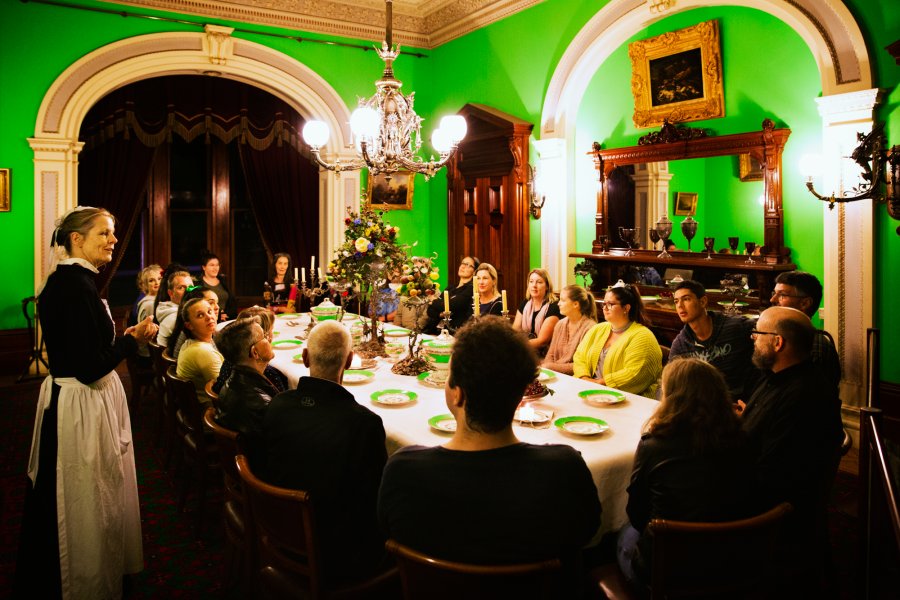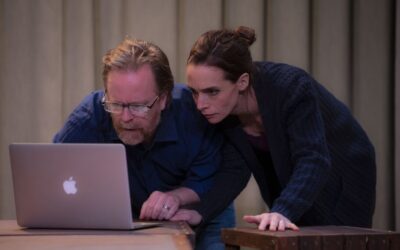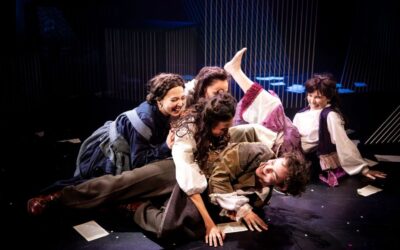By Cedar Brown
Coming into the foyer of the Werribee Mansion’s adjacent hotel at 7.45 for an 8pm start to the show, we happened across a TV playing the women’s soccer world cup. Australia vs France playing for who goes into the semi finals, nil all. The would-be audience watched as the Matilda’s participated in a penalty shootout: cheering and yelling at the TV. The stage manager checked us all in, but 5 penalty shots in and still a draw, we were fixed to the screen. Behind me, I heard a call being made: we weren’t able to start the show yet because nobody would go until the game ended. 8.01: France missed, Australia kicked a goal, and we erupted at the win before dutifully lining up to receive our instructions. And so began a show that continued to be deeply interactive and responsive to what was going on in the room. Performers Alaine Beek and Ross Daniels (as servants Maggie and Mr Duncan) were excellent at responding to the audience in real time, their improvisational attunement giving the sense that we could relax and participate in their trustworthy hands. And this buy-in was needed for a show that moved the audience in and out of multiple spaces across its one and a half hour duration. Beek used her warmth, practicality and humour to shepherd the audience through a host of spaces and configurations, while Daniels punctuated the piece with strong physical comedy.
The performance had an elastic relationship with time. Through storytelling, we inhabited the world of the wealthy mid-1800s settler family, the Chirnsides – encouraged to conjure a vision of the empty rooms being full of party guests or children. Quips linking the world of the play to the present, however, reminded us that we are not actually part of this story – that we were engaging with a historical artifact. At the same time, our companions Maggie and Mr Duncan were trapped in an aggrandised idea of the past – even though it was a past where, as they jokingly reminded us, their servant status was a form of class oppression that trapped them in unequal and exploitative conditions. In this context, I found myself wondering what it means to re-animate stories from the colonial past of Melbourne’s founding. The Chirnsides, as early settlers, displaced Bunurong and Wadawurrung people to establish large scale farming and build the beautiful, Italianate mansion wherein the performance is set. To preserve an old house like this as a museum is for the council to inherently honour the memory of the colonial figures who inhabited it. Experiencing it in this playful way left open a space for moments of witty critique that tours of such houses often do not. But I would have liked to see the play take more seriously the colonial legacy it is situated within.
Gender and sexuality are also central themes of the performance – with the gender dynamics and compulsory heterosexuality of mid-1800s settler culture embodied by the performers and subtly critiqued. While it was interesting to see these gendered dynamics explored, the performance left room to push the critique further. Another related aspect was an interactional dynamic where men and women in the audience were asked to do different things. While the performers nodded at queer inclusion by framing gender as “those who identify as…” and giving the option for those who “float in the middle” to choose where they went, as the only visibly gender non-conforming nonbinary person in the audience I felt highlighted in an uncomfortable way. I found myself curious about ways that such a show might invite the audience into participatory gender-play that are validating both for those who fit binary gender norms and those who don’t.
Comedy is the focal point of the show. The horror elements – set pieces appearing or moving seemingly by themselves – were more playful than scary. (This said, there were a couple of light jump scares to keep you on your toes!) Set, costume, and lighting were essential to the piece, pulled off in a way that was practised and professional while retaining a slightly ad hoc goofiness. The delightful stage manager did a great job of holding it all together, and brought a joyful presence to the start and end of the night.
As the evening drew to a close, we shared a glass of champagne and the creatives reflected on the show’s long run. There was such a warmth and joy in the air, the team full of heart. What Was That? brings you closer to the people you came with – couples lightly teased, families jostled, the farcical humour causing you to turn to your companions with a smile or a laugh. Beek and Daniels do a wonderful job of drawing the audience into a warm playfulness – the whole show felt like being in on a joke. After 20 years, it is clear that there is a real comfort and familiarity in having seen and done the show so many times. Even though the play deals at times with heavy topics, there is a real commitment to fun and to joy. 1000 shows is an incredible milestone, and despite its ghostly themes, the play is still very much alive.
Image: Imran Kashem





